Régiolis
The Régiolis is a category of multiple unit train built by Alstom coming from the Coradia family. The first train was presented on July 4, 2013 in Aquitaine, and the first commissioning took place on April 22, 2014 on the TER Aquitaine network, more than a year behind the initial schedule.
| Régiolis | |
|---|---|
Régiolis at Montreuil-Bellay station. | |
 Interior of a B 83511 Régiolis of TER Alsace | |
| Manufacturer | Alstom |
| Family name | Coradia |
| Entered service | 2013 |
| Number in service | 242 |
| Operator(s) | SNCF (TER, Intercités) SNTF |
| Specifications | |
| Low-floor | Yes |
| Articulated sections | 4 or 6 |
| Transmission | Electric |
| Electric system(s) | DC 1.5 kV AC single-phase 25 kV 50 Hz AC single-phase 15 kV 16.7 Hz |
| Track gauge | 1,435 mm (4 ft 8 1⁄2 in) standard gauge |
History
The versatile carrier
In the 2000s, the delivery of several hundred new trains, X TER, A TER, AGC, or TER 2N NG provided significant modernizations of the regional electrical and diesel fleet. However, in the early 2010s, old types of rolling stock dating from the 1970s and 1980s continued to operate, it became necessary to continue the renewal and growth of the fleet during the period 2013 - 2022 due increasing TER network usage. This desire manifested itself with a call for tenders from SNCF, for the design of a new type of train, the "versatile carrier" ("porteur polyvalent" in French). Following the Grenelle Environnement and the successful usage of AGC dual-mode equipment, this equipment must not only have a diesel version, but electrical and dual-mode versions, to avoid any usage of the diesel engines where overhead catenary is available.[1]
While Bombardier Transportation won a few years ago the contract for 700 AGC trains for the TER, Alstom won the contract this time, allowing the manufacturer to manufacture new equipment for French regional traffic. The imagined train, the Régiolis, is offered in electric and dual-mode-bicurrent version, allowing these trains to run on the entire French normal-gauge network, like the B 82500 of the competing manufacturer Bombardier. In addition, a tricurrent version with 15 kV at a frequency of 16.7 Hz is also available, allowing cross-border services to Germany and Switzerland.[2] The Régiolis is presented as "a modular train that knows how to do everything" and proposed in three versions with three, four or six coaches, and three types of development, peri-urban, regional or intercity. Like the manufacturer's AGV, or Bombardier Z 50000 and Regio 2N, the train is designed with an articulated architecture, with the bogies arranged between the cars.[1]
Orders
The first eight regions to order the Regiolis were Alsace, Aquitaine, Lower Normandy, Upper Normandy, Lorraine, Midi-Pyrénées, Pays de la Loire and Picardie.[3] The order for Lower Normandy, made in 2009, covers 15 trains for a total of 148 million of euros[4][5]
Distribution of Orders
| Régions (before merger) | Régions (after merger) | Number of Cars | Series | Type | Service | Ordered |
|---|---|---|---|---|---|---|
| Rhône-Alpes | Auvergne-Rhône-Alpes | 4 | B 84500 | Bi Mode-dual voltage | Régional | 12 |
| 4 | Z 31500 | Electric (tritension) | Régional | 27 | ||
| Bourgogne-Franche-Comté | - | 4 | Z 51500 | Electric | Régional | 24 |
| 6 | Z 5xxxx | Electric | Interville | 16 | ||
| Center-Loire Valley | - | 4 | B 84500 | Bi Mode-dual voltage | Régional | 3 |
| Alsace
Lorraine |
Grand Est | 4 | B 83500 | Bi Mode-dual voltage | Suburban | 6 |
| 6 | B 83500 | Bi Mode-dual voltage | Suburban | 19 | ||
| 4 | B 84500 | Bi Mode-dual voltage | Régional | 10 | ||
| 6 | B 85000 | Bi Mode-dual voltage | Intercités | 19 | ||
| Nord-Pas-de-Calais
Picardie |
Hauts-de-France | 6 | B 84500 | Bi Mode-dual voltage | Régional | 27 |
| Intercités | - | 6 | B 85000 | Bi Mode-dual voltage | Intercités | 20 |
| 4 | Z 51500 | Electric | Intercités | 9 | ||
| Normandy | - | 6 | B 84500 | Bi Mode-dual voltage | Interville | 15 |
| 4 | B 84900 | Bi Mode-dual voltage | Régional | 10 | ||
| Aquitaine | New Aquitaine | 4 | Z 51500 | Electric | Régional | 22 |
| 4 | B 84500 | Bi Mode-dual voltage | Régional | 20 | ||
| Midi-Pyrénées | Occitanie | 4 | B 83500 | Bi Mode-dual voltage | Suburban | 23 |
| 4 | B 84500 | Bi Mode-dual voltage | Régional | 3 | ||
| 4 | Z 54900 | Electric | Suburban | 15 | ||
| Provence-Alpes-Côte d'Azur | - | 4 | B 84500 | Bi Mode-dual voltage | Régional | 10 |
| Pays de la Loire | - | 4 | B 84500 | Bi Mode-dual voltage | Régional | 10 |
| 4 | Z 51500 | Electric | Régional | 10 | ||
| Total | 357 | |||||
Operators and Routes
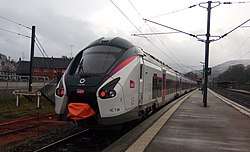
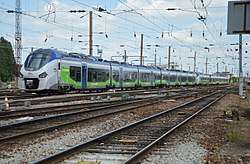
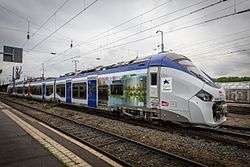
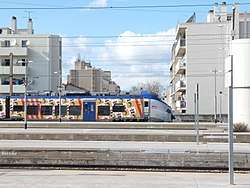

.jpg)
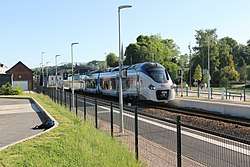
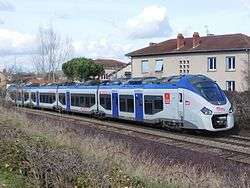
Intercités
- Nantes - Bordeaux
- Nantes - Lyon
- Paris - Granville
- Paris - Boulogne-sur-Mer
- Clermont-Ferrand - Nîmes via Le Cévenol
- Bourges - Montluçon
- Toulouse - Hendaye
- Bordeaux - Ussel
- Bordeaux - Limoges
TER
TER Auvergne-Rhône-Alpes
- Clermont-Ferrand – Lyon
- Clermont-Ferrand – Moulins – Nevers
- Clermont-Ferrand – Vic-le-Comte
- Clermont-Ferrand – Thiers
- Clermont-Ferrand – Gannat
- Clermont-Ferrand – Brioude
Léman Express
- L1 : Coppet – Genève – Annemasse – Thonon – Évian
- L2 : Coppet – Genève – Annemasse – La Roche-sur-Foron – Annecy
- L3 : Coppet – Genève – Annemasse – La Roche-sur-Foron – Saint-Gervais-Le Fayet
- L4 : Coppet – Genève – Annemasse
- L5 : Genève – La Plaine
- L6 : Genève – Bellegarde
TCR Bourgogne-Franche-Comté
- Dijon-Ville – Dole – Besançon-Viotte
- Besançon- Viotte – Belfort
- Belfort - Besançon-Viotte - Lons-le-Saunier - Bourg-en-Bresse - Lyon-Part-Dieu
TER Centre-Val de Loire
- Bourges – Montluçon.
TER Grand Est
TER Alsace
- Strasbourg – Molsheim – Barr - Saint-Dié-des-Vosges
- Strasbourg - Haguenau
- Mulhouse – Bâle
- Colmar - Metzeral
- Strasbourg – Mulhouse
- Strasbourg – Sarreguemines
- Strasbourg - Nancy / Metz.
TER Lorraine
- Épinal – Saint-Dié
- Nancy – Pont-St-Vincent – Contrexéville – Culmont-Chalindrey
- Nancy – Épinal – Belfort
- Nancy – Épinal – Remiremont
- Nancy – Lunéville – Saint-Dié
TER Hauts-de-France
- Amiens – Laon
- Paris – Amiens – Boulogne
- Paris-Nord – Laon
- Amiens – Paris-Nord
- Amiens – Lille-Flandres
- Amiens – Calais-Ville
TER Normandie
- Rouen – Dieppe
TER New Aquitaine
- Bordeaux-Saint-Jean – Agen
- Bordeaux-Saint-Jean – Langon
- Bordeaux-Saint-Jean – Hendaye
- Bordeaux-Saint-Jean – Pointe de Grave
- Bordeaux-Saint-Jean – Pau
- Bordeaux-Saint-Jean – Coutras
- Bordeaux-Saint-Jean - Libourne - Coutras - Angouleme
- Tarbes – Hendaye
- La Rochelle – Poitiers
- La Rochelle – Bordeaux-Saint-Jean
- Bordeaux-Saint-Jean – Limoges
- Bordeaux-Saint-Jean – Ussel
TER Occitanie
- Toulouse – Agen
- Toulouse – Carmaux
- Toulouse – Rodez
- Toulouse – Mazamet
- Toulouse – Latour-de-Carol - Enveitg
- Toulouse – Pau
- Toulouse – Auch
- Toulouse – Avignon-Centre
- Toulouse – Brive-la-Gaillarde.
TER Pays de la Loire
- Nantes – Angers
- Nantes – Cholet
- Cholet – Angers
- Nantes – La Rochelle
TER Provence-Alpes-Côte d'Azur
- Avignon-TGV – Avignon-Centre
- Marseille – Arles – Avignon-Centre
- Toulon – Marseille
- Marseille-Saint-Charles – Miramas via Port-de-Bouc
Future Operators and Routes
CDG Express
The region Ile-de-France has not made orders for Regiolis trains. However, a link located only in this region, will operate by 2024 a dozen trains, specially designed for airport connections. These trains will be operated on the Charles de Gaulle Express, a new line directly connecting the Gare de Paris-Est to terminal 2 of the Paris Charles de Gaulle. These trains will be operated by a new company, bringing together Keolis (subsidiary of the SNCF) and the RATP.
- Paris Gare de-Est – Paris Charles de Gaulle Airport
Manufacturing and testing
On December 1, 2011 three workers making adjustments on Alstom's private test track in Tronville-en-Barrois (Meuse) were killed by a train under test.[6] This railway test center tests all Régiolis trains.[7]
This train is manufactured at several Alstom sites:[8]
- Design: Saint-Ouen
- Design and assembly: Reichshoffen
- Engines: Ornans
- Bogies: Le Creusot
- Traction chains: Tarbes
- Embedded computing: Villeurbanne
The Régiolis received approval for commercial operation, issued by the EPSF in March 2014. The first trains circulated in April 2014 in Aquitaine, Picardy, Lorraine and Alsace.
The width of Regiolis and Regio 2N is incompatible with the gauge available in a number of stations. About 1,300 edges of platforms have had to be retouched to clear a few extra centimeters, to allow the passage of these new trains. The cost of this operation is estimated at 50 million euros. While this kind of minimal adaptations of infrastructure to new equipment is routine, the lack of anticipation and the fear of higher prices raised controversy in May 2014.[9]
The first Régiolis, a Z 51500 four car, was introduced into commercial service more than a year behind the initial forecasts on April 22, 2014 in Aquitaine, on the Bordeaux - Agen route. The same day, Lorraine put into commercial service its first two-mode regional train B 84500 between Nancy and Saint-Dié-des-Vosges. Finally, six days later, on April 28, Alsace put into service a bi-mode element peri-urban B 83500 between Strasbourg and Sarreguemines. A month later, May 26, it was the turn of Picardy to introduce its first B 84500 on the Paris-Nord - Laon route.
Incident
As of May 7, 2018, all Regiolis (and Coradia Liner) trainsets are limited to the speed of the "V140" craft (imposing a speed limit of 140 km/h, as well as other speed reductions on certain portions). line). Indeed, during tests carried out in April, it was found, at 160 km/h, that the emergency braking distances exceeded those which allowed the approval of this type of equipment.[10] This restriction, caused by premature aging of the brake linings which will therefore have to be replaced, should be lifted in October of the same year.[10]
See also
References
- Olivier Constant, Les automotrices bicourant et les trams-trains, dans Le Train, p.81.
- ALSTOM. "Train régional Coradia Polyvalent : Une géométrie variable". alstom.com (in French). Retrieved 16 August 2015..
- "Le futur train régional d'Alstom bientôt opérationnel". La gazette des communes. 14 February 2011..
- « Paris-Granville : de nouveaux trains sur les rails », article de La Manche Libre du 3 novembre 2012, consulté le 14 septembre 2013.
- SNCF - Régiolis sur la ligne Paris-Granville, dossier de presse du 18 December 2013.
- "Lorraine: train mortel d'Alstom: l'horaire de l'essai a été avancé". L'Est Républicain (in French). December 2, 2011.
- "Régiolis : passage meusien obligé". L'Est Républicain (in French). October 12, 2015.
- http://archive.wikiwix.com/cache/?url=http%3A%2F%2Fwww.alstom.com%2Ffr%2Fpress-centre-francais%2F2018%2F01%2Falstom-fournira-14-rames-coradia-polyvalent-aux-regions-bourgogne-franche-comte-et-grand-est%2F
- "Pour renouveler ses TER, la SNCF commande des rames... trop larges". Le Monde (in French). May 20, 2014.
- Cognasse, Olivier (June 8, 2018). "Alstom contraint de revoir le freinage de ses trains Régiolis, au grand dam de la SNCF". L'Usine Nouvelle (in French).